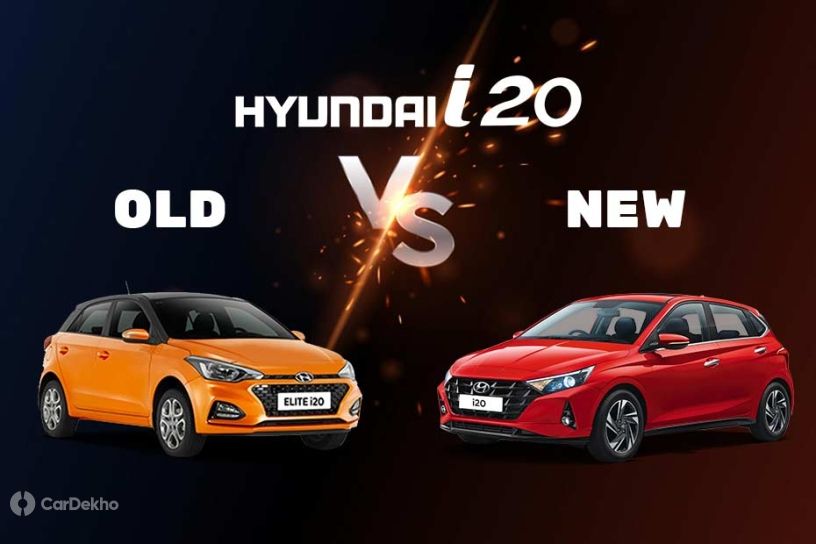Hyundai i20: Old vs New
Modified On Nov 06, 2020 06:33 PM By Dhruv
- Write a comment
Hyundai has launched the third-gen i20. Here’s how it’s different from the outgoing model

The i20 has been one of India’s go-to premium hatchbacks over the years but its long run in the market means that its appeal has started to fade. To put things right, Hyundai has launched its new generation model and it is a significant departure from the outgoing car. It is still typically Hyundai with its feature-rich cabin but the design, engines and platform and price are all new. In fact, it has also dropped the ‘Elite’ tag from its name. Here’s the difference:
Design

The second-gen Elite i20 was one of the last of the cars that was still moulded on Hyundai’s fluidic 2.0 design language. The third-gen i20 embodies Hyundai’s sensuous sportiness design theme like the new Creta. The design still flows but the hatchback’s surface now features sharper cuts and angular design details. Long story short, the i20’s design looks thoroughly modern and unlike anything else in the market.
Size
The new i20 has grown in size as well and is based on a new platform. It sits 10mm longer, 41mm wider and at the same height as the second-gen i20 (used to be known as Elite i20). The wheelbase has also grown in size by 10mm. The boot space is up by 26 litres.
| Measurements |
Third-gen i20 |
Second-gen Elite i20 |
| Length |
3995mm |
3985mm |
| Width |
1775mm |
1734mm |
| Height |
1505mm |
1505mm |
| Wheelbase |
2580mm |
2570mm |
| Boot space |
311 litres |
285 litres |
Also Read: New Hyundai i20 vs Rivals: What Do The Prices Say?
Powertrain
The powertrain options for the i20 have also been revamped. Before we dived into the BS6 era, the second-gen Elite i20 could be had with a 1.4-litre diesel engine that made 90PS and 220Nm of peak torque, and it could only be had with a 6-speed manual transmission. As BS6 norms came into effect, the diesel was given the boot and only the 1.2-litre petrol engine that makes 83PS and 114Nm remained.

However, with the new third-gen i20, Hyundai will be offering a range of three engine options. The first is the same 1.2-litre petrol, but you will now have the option of a CVT. The CVT equipped unit gets an integrated variable intake manifold and now pumps out 88PS instead of manual’s 83PS. Then there is the turbo-petrol and lastly the 1.5-litre diesel engines from the Venue which are new to the i20. Take a look at each of their specifications in the table below.
| Engine |
1.2-litre petrol |
1.0-litre turbo-petrol |
1.5-litre diesel |
| Power |
83PS/88PS (CVT) |
120PS |
100PS |
| Torque |
114Nm |
172Nm |
240Nm |
| Transmission |
5-speed MT/CVT |
6-speed iMT/ 7-speed DCT |
6-speed MT |
The i20 now comes with a bunch of new engine and transmission options, although the diesel engine still continues to lack the option of an automatic transmission. It is the first in the segment to offer the iMT clutchless manual option, a Hyundai Group introduction to the Indian masses.
Features
The second-gen Elite i20 was always a feature-laden car, offering the very best in the segment. It was already specced with features like automatic headlamps, climate control, a rear view camera, ISOFIX child seat mounts, projector headlights, LED DRLs, tilt and telescopically adjustable steering wheel, and auto folding ORVMs. This are features still not common on budget cars.


The new i20 however pushes the envelope with features such as LED headlamps, projector fog lamps, a sunroof, a BOSE sound system, connected car technology with goodies like remote cabin start with cabin pre-cool, an air purifier, wireless smartphone charging, a digital instrument cluster and a new segment largest 10.25-inch touchscreen infotainment system. The i20 continues its tradition of being the best equipped car in the premium hatchback space.
Warranty


The Elite i20 used to be available with a 3 years/1,00,000km warranty from the factory, along with three years of road side assistance. Hyundai has since introduced a new after-sales experience for its customers by offering more options to choose between. You can have the same old coverage, or choose between a 4 year/50,000km or a 5 year/40,000km standard warranty depending on your intended usage.
Price
| Model |
Third-gen i20 |
Second-gen Elite i20 |
| Price Range |
Rs 6.80 lakh to Rs 11.18 lakh |
Rs 6.49 lakh to Rs 8.30 lakh |
All prices ex-showroom India.
The third-gen i20 is a lot pricier than before, especially at the top end. Even when we compare the price of the two while keeping a similar powertrain setup, the i20 is now costlier by anywhere between Rs 20,000 and Rs 90,000! The costliest variant of the i20 is now knocking on the doors of premium variants of sub-4 metre SUVs.
Price comparison of 1.2-litre petrol engine with 5-speed MT
| Variant |
Third-gen i20 |
Second-gen Elite i20 |
Difference |
| Magna |
Rs 6.80 lakh |
Rs 6.57 lakh (Magna+) |
|
| Sportz |
Rs 7.60 lakh |
Rs 7.38 lakh (Sportz+) |
|
| Asta |
Rs 8.70 lakh |
NA |
|
| Asta (O) |
Rs 9.20 lakh |
Rs 8.33 lakh |
|


Safe to say, the i20’s price has grown by leaps and bounds, making it the most expensive premium hatchback on sale in India.
Read More on : i20 on road price
5 out of 6 found this helpful















